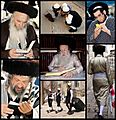Haredi Judaism facts for kids
| Part of a series on | |||
|---|---|---|---|
|
|||
| Judaism | |||
| Category | |||
| Jewish religious movements | |||
| Orthodox (Haredi • Hasidic • Modern) | |||
| Conservative • Reform | |||
| Reconstructionist • Renewal • Humanistic | |||
| Jewish philosophy | |||
| Principles of faith • Kabbalah • Messiah • Ethics | |||
| Chosenness • Names of God • Musar | |||
| Religious texts | |||
| Tanakh (Torah • Nevi'im • Ketuvim) | |||
| Ḥumash • Siddur • Piyutim • Zohar | |||
| Rabbinic literature (Talmud • Midrash • Tosefta) | |||
| Religious Law | |||
| Mishneh Torah • Tur | |||
| Shulchan Aruch • Mishnah Berurah | |||
| Kashrut • Tzniut • Tzedakah • Niddah • Noahide laws | |||
| Holy cities | |||
| Jerusalem • Safed • Hebron • Tiberias | |||
| Important figures | |||
| Abraham • Isaac • Jacob | |||
| Moses • Aaron • David • Solomon | |||
| Sarah • Rebecca • Rachel • Leah | |||
| Rabbinic sages | |||
| Jewish life cycle | |||
| Brit • Pidyon haben • Bar/Bat Mitzvah | |||
| Marriage • Bereavement | |||
| Religious roles | |||
| Rabbi • Rebbe • Posek • Hazzan/Cantor | |||
| Dayan • Rosh yeshiva • Mohel • Kohen/Priest | |||
| Religious buildings & institutions | |||
| Synagogue • Beth midrash • Mikveh | |||
| Sukkah • Chevra kadisha | |||
| Holy Temple / Tabernacle | |||
| Jewish education | |||
| Yeshiva • Kollel • Cheder | |||
| Religious articles | |||
| Sefer Torah • Tallit • Tefillin • Tzitzit • Kippah | |||
| Mezuzah • Hanukiah/Menorah • Shofar | |||
| 4 Species • Kittel • Gartel | |||
| Jewish prayers and services | |||
| Shema • Amidah • Aleinu • Kaddish • Minyan | |||
| Birkat Hamazon • Shehecheyanu • Hallel | |||
| Havdalah • Tachanun • Kol Nidre • Selichot | |||
| Judaism & other religions | |||
| Christianity • Islam • Judeo-Christian | |||
| Abrahamic faiths | |||
| Related topics | |||
| Antisemitism • The Holocaust • Israel • Zionism | |||
Haredi (Hebrew: חֲרֵדִי Ḥaredi) is the most conservative form of Orthodox Judaism and is known as Ultra-Orthodox Judaism
Haredi Judaism consists of many spiritual and cultural groups, and is divided into Hasidic sects with streams from Eastern Europe and Sephardic Haredim. The two are different in many aspects, including their beliefs, lifestyles, religious practice and philosophy, and isolation from the general culture where they live.
Most Haredi Jews currently live in Israel, North America and Western Europe. Their population is growing very fast due to a high birth rate. It doubles every 12 to 20 years.
The estimates of the number of Haredim in the entire world are difficult to measure, because the definition of the word may or may not apply to some people. In addition there has been a lack of data collection and rapid change over time. One newspaper article estimated there were approximately 1.3 million Haredi Jews as of 2011.
The Me'a She'arim neighbourhood in Jerusalem is mainly populated by Haredi Jews.
Images for kids
-
Hasidic boys in Łódź, 1910
-
Haredi Jewish women and girls in Mea Shearim, Jerusalem, 2013
-
The Bais Yaakov graduating class of 1934 in Łódź, Poland
-
Hasidim walk to the synagogue, Rehovot, Israel.
-
Haredi Rabbis and students writing a Torah scroll (Haredi settlement of Beitar Illit, Gush Etzion)
-
Hasidic family on the street in Borough Park, Brooklyn
See also
 In Spanish: Judaísmo ultraortodoxo para niños
In Spanish: Judaísmo ultraortodoxo para niños

















